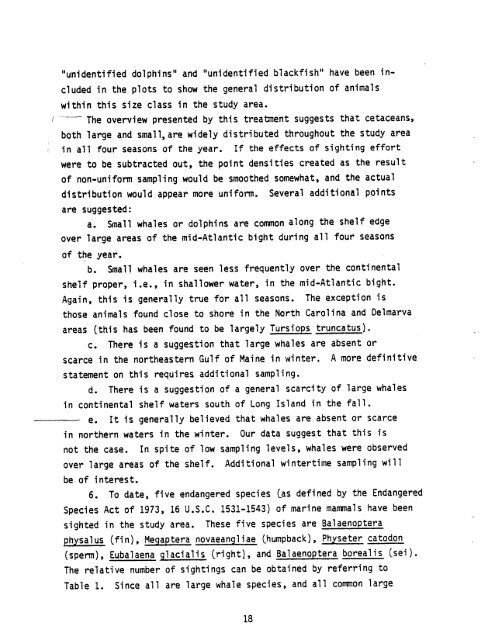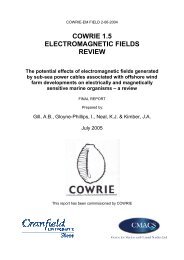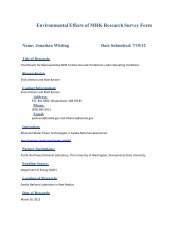Access Document
Access Document
Access Document
Create successful ePaper yourself
Turn your PDF publications into a flip-book with our unique Google optimized e-Paper software.
"unidentified dolphins" and "unidentified blackfish" have been in-<br />
cluded in the plots to show the general distribution of animals<br />
within this size class in the study area .<br />
!- The overview presented by this treatment suggests that cetaceans,<br />
both large and small,are widely distributed throughout the study area<br />
in all four seasons of the year . If the effects of sighting effort<br />
were to be subtracted out, the point densities created as the result<br />
of non-uniform sampling would be smoothed somewhat, and the actual<br />
distribution would appear more uniform . Several additional points<br />
are suggested :<br />
a . Small whales or dolphins are common along the shelf edge<br />
over large areas of the mid-Atlantic bight during all four seasons<br />
of the year .<br />
b . Small whales are seen less frequently over the continental<br />
shelf proper, i .e ., in shallower water, in the mid-Atlantic bight .<br />
Again, this is generally true for all seasons . The exception is<br />
those animals found close to shore in the North Carolina and Delmarva<br />
areas (this has been found to be largely Tursio s truncatus ) .<br />
c . There is a suggestion that large whales are absent or<br />
scarce in the northeastern Gulf of Maine in winter . A more definitive<br />
statement on this requires additional sampling .<br />
d . There is a suggestion of a general scarcity of large whales<br />
in continental shelf waters south of Long Island in the fall .<br />
e . It is generally believed that whales are absent or scarce<br />
in northern waters in the winter . Our data suggest that this is<br />
not the case . In spite of low sampling levels, whales were observed<br />
over large areas of the shelf . Additional wintertime sampling will<br />
be of interest .<br />
6 . To date, five endangered species (as defined by the Endangered<br />
Species Act of 1973, 16 U .S .C . 1531-1543) of marine mammals have been<br />
sighted in the study area . These five species are Balaenoptera<br />
physalus (fin), Megaptera novaeangliae (humpback), Physeter catodon<br />
(sperm), Eubalaena qiacialis (right), and Balaenoptera borealis (sei) .<br />
The relative number of sightings can be obtained by referring to<br />
Table 1 . Since all are large whale species, and all common large<br />
18




